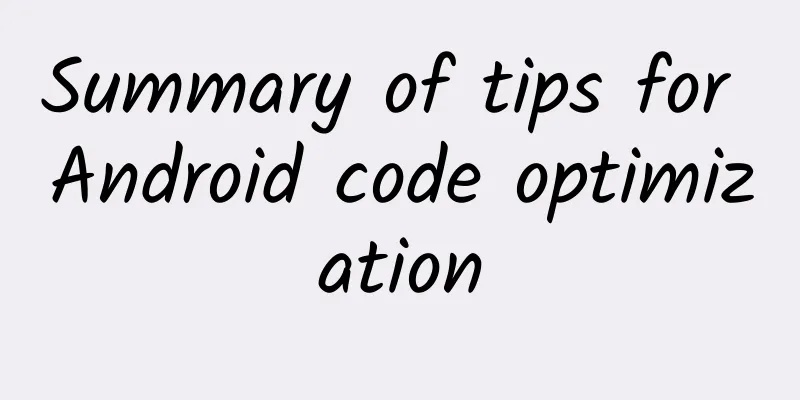Summary of tips for Android code optimization

|
Preface This article mainly introduces some small details of optimization techniques. When these small techniques are used in combination, they are still useful for improving the performance of the entire Android App, but they cannot significantly improve the performance. Choosing the right algorithm and data structure should be your primary consideration, which will not be covered in this article. You should use the tips in this article as a habit for writing code in your daily life, which can improve the efficiency of your code.
Code performance optimization suggestions Generally speaking, efficient code needs to meet the following two rules:
The execution effect of the code will be affected by many factors such as device CPU, device memory, system version, etc. In order to ensure that the code can run well on different devices, it is necessary to optimize the efficiency of the code. Avoid creating unnecessary objects Although GC can recycle unused objects, allocating memory for these objects and recycling them also consumes resources. Therefore, please try to avoid creating unnecessary objects. Here are some examples to illustrate this problem:
Choose Static instead of Virtual If you don't need to access the value field of an object, make sure the method is static, so that the method call will be 15%-20% faster. This is a good habit because you can know from the method declaration that the call cannot change the state of the object. Constants are declared as Static Final First look at the following statement
The compiler will use the initialization method to initialize the above value when the class is used. When accessing it later, it will need to look it up first before returning the data. We can use static final to improve performance:
At this time, you no longer need the above method to perform redundant lookups. Therefore, please declare constants as static final types as much as possible. Avoid Internal Getters/Setters In native languages like C++, it is common to use getters (i = getCount()) instead of accessing variables directly (i = mCount). This is a good habit to write in C++, and is often adopted by other object-oriented languages such as C# and Java, because the compiler usually inlines access, and you can add code in getters/setters at any time if you need to restrict or debug variables. However, on Android, this is a bad practice. Virtual method calls are more expensive than direct access to variables. So the reasonable approach is: use getters/setters in object-oriented design, but you should access variables directly inside the class. Without JIT (Just In Time Compiler), direct access to variables is 3 times faster than calling getters. With JIT, direct access to variables is 7 times faster than accessing through getters. Note that if you use ProGuard, you can get the same effect because ProGuard can inline accessors for you. Using the enhanced For loop Compare the following three looping methods:
zero() is the slowest because the JIT cannot optimize it. one() is slightly faster. two() is the fastest without JIT, but after JIT, it is almost as fast as method one(). It uses the enhanced loop method for-each. Use package-level access instead of private access for inner classes Refer to the following code
We have defined a private inner class (Foo$Inner) that directly accesses private methods and private member objects in the outer class. This is legal and the code will print "Value is 27" as expected. The problem is that VM thinks it is illegal to directly access private members of Foo class in (Foo.Inner) because Foo and (Foo.Inner) are different classes. Even though Java language allows inner classes to access private members of outer classes. To remove this difference, the compiler generates some mock functions:
Whenever the inner class needs to access the mValue member in the outer class or needs to call the doStuff() function, it calls these static methods. This means that the code above can be reduced to accessing member variables through accessor functions. Earlier we said that accessing through accessors is slower than accessing fields directly. So, this is an example of a specific language usage causing performance degradation. If you are using code like this in a performance hotspot, you can declare the fields and methods that inner classes need to access as package-level access instead of private access. Unfortunately, this means that other classes in the same package can also access these fields directly, so you can't do this in the public API. Avoid using float types In the Android system, the data access speed of the float type is half that of the int type. Try to give priority to the int type. Using library functions Try to use some encapsulated library functions such as System.arraycopy(), which are more than 9 times more efficient than manually writing copy implementations. Tip: Also see Josh Bloch's Effective Java, item 47. Use native functions with caution When you need to migrate existing native code to Android, please use JNI with caution. If you want to use JNI, please learn JNI Tips Misconceptions about performance Before JIT, using a specific data type is indeed more efficient than using an abstract data type. (For example, using HashMap is more efficient than Map.) There is a misconception that the efficiency is twice as high, but it is actually only about 6%. Moreover, after JIT, there is not much difference between them. About Measurement The data in the above document is the actual running effect of Android. We can use Traceview to measure, but the measured data is not JIT optimized, so the actual effect should be slightly better than the measured data. |
<<: The last unknown blue ocean of Android emulator mobile games
>>: Anti-aliasing processing method for image deformation
Recommend
How to increase the number of likes on Tik Tok? How to increase the number of likes on Douyin?
There are many popular videos on Douyin with very...
Why do I advise you to lose weight in winter? Because the effect is so good
As soon as winter comes, men, women, old and youn...
Is Oumuamua really an alien spacecraft? Scientists have put forward the latest answer
Is Oumuamua an alien spaceship? Scientists have p...
In the competition for best-selling models, domestic mobile phones still cannot escape the strategy of flooding the market with products
In the six months since January this year, the dom...
Elite launches Liva X mini PC, supports dual-screen display output
Although the mini PC market has never been mainst...
How many points are required for admission to Wuhan University? How many points do I need in the 2020 Hubei College Entrance Examination to apply for Wuhan University?
On the afternoon of July 23, admissions officers ...
For online operation and promotion, can the hit H5 that goes viral be replicated?
In the past two years, we have seen H5s produced ...
The equivalent of the Earth's 12-year hot and cold cycle! Who "directed" Jupiter's magical "mirror climate"?
40 years of research confirms Jupiter's anoma...
Women must do these 10 health checks, especially after the age of 30!
If you have special health conditions or needs, p...
Guangzhou appearance scoring mini program function, how much does it cost to develop the WeChat appearance scoring mini program?
“Everyone loves beauty,” especially female friends...
Boyong Investment Research Think Tank in 2021 will open up the underlying investment logic
2021 Boyong Investment Research Think Tank, Openi...
If an electric car is not used for a long time, the battery will "starve to death"?
Audit Expert: Wang Jinlu, Director of Power Suppl...
A 24-year-old boy fainted after having his teeth extracted and died after a craniotomy! Can wisdom teeth still be extracted?
Recently, #A 24-year-old boy fainted and died aft...
Talking about WeChat ban again: Why do we need "net neutrality"?
[[127866]] Last week, I proposed an extended conc...
Do you care about what others think?
© The Good Men Project Leviathan Press: “You will...








![[Creative Cultivation Program] Is there any scientific basis for the claim that spanking can improve IQ?](/upload/images/67f265d8d2f16.webp)
